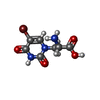[English] 日本語
 Yorodumi
Yorodumi- PDB-1mqh: Crystal Structure of the GluR2 Ligand Binding Core (S1S2J) in Com... -
+ Open data
Open data
- Basic information
Basic information
| Entry | Database: PDB / ID: 1mqh | ||||||
|---|---|---|---|---|---|---|---|
| Title | Crystal Structure of the GluR2 Ligand Binding Core (S1S2J) in Complex with Bromo-Willardiine at 1.8 Angstroms Resolution | ||||||
 Components Components | glutamate receptor 2 | ||||||
 Keywords Keywords | MEMBRANE PROTEIN / ionotropic glutamate receptor / GluR2 / ligand binding core / S1S2 / partial agonist / willardiines / bromo-willardiine | ||||||
| Function / homology |  Function and homology information Function and homology informationspine synapse / dendritic spine neck / dendritic spine head / cellular response to amine stimulus / perisynaptic space / Activation of AMPA receptors / ligand-gated monoatomic cation channel activity / AMPA glutamate receptor activity / response to lithium ion / Trafficking of GluR2-containing AMPA receptors ...spine synapse / dendritic spine neck / dendritic spine head / cellular response to amine stimulus / perisynaptic space / Activation of AMPA receptors / ligand-gated monoatomic cation channel activity / AMPA glutamate receptor activity / response to lithium ion / Trafficking of GluR2-containing AMPA receptors / kainate selective glutamate receptor activity / AMPA glutamate receptor complex / cellular response to glycine / extracellularly glutamate-gated ion channel activity / immunoglobulin binding / asymmetric synapse / ionotropic glutamate receptor complex / conditioned place preference / regulation of receptor recycling / glutamate receptor binding / Unblocking of NMDA receptors, glutamate binding and activation / positive regulation of synaptic transmission / regulation of synaptic transmission, glutamatergic / response to fungicide / cytoskeletal protein binding / glutamate-gated receptor activity / regulation of long-term synaptic depression / extracellular ligand-gated monoatomic ion channel activity / cellular response to brain-derived neurotrophic factor stimulus / presynaptic active zone membrane / glutamate-gated calcium ion channel activity / somatodendritic compartment / dendrite membrane / ionotropic glutamate receptor binding / ligand-gated monoatomic ion channel activity involved in regulation of presynaptic membrane potential / ionotropic glutamate receptor signaling pathway / dendrite cytoplasm / synaptic membrane / dendritic shaft / SNARE binding / transmitter-gated monoatomic ion channel activity involved in regulation of postsynaptic membrane potential / synaptic transmission, glutamatergic / PDZ domain binding / protein tetramerization / establishment of protein localization / postsynaptic density membrane / cerebral cortex development / modulation of chemical synaptic transmission / receptor internalization / Schaffer collateral - CA1 synapse / terminal bouton / synaptic vesicle / synaptic vesicle membrane / presynapse / signaling receptor activity / amyloid-beta binding / presynaptic membrane / growth cone / scaffold protein binding / perikaryon / chemical synaptic transmission / dendritic spine / postsynaptic membrane / neuron projection / postsynaptic density / axon / external side of plasma membrane / neuronal cell body / dendrite / synapse / protein kinase binding / protein-containing complex binding / glutamatergic synapse / cell surface / endoplasmic reticulum / protein-containing complex / identical protein binding / membrane / plasma membrane Similarity search - Function | ||||||
| Biological species |  | ||||||
| Method |  X-RAY DIFFRACTION / X-RAY DIFFRACTION /  FOURIER SYNTHESIS / Resolution: 1.8 Å FOURIER SYNTHESIS / Resolution: 1.8 Å | ||||||
 Authors Authors | Jin, R. / Banke, T.G. / Mayer, M.L. / Traynelis, S.F. / Gouaux, E. | ||||||
 Citation Citation |  Journal: Nat.Neurosci. / Year: 2003 Journal: Nat.Neurosci. / Year: 2003Title: Structural basis for partial agonist action at ionotropic glutamate receptors Authors: Jin, R. / Banke, T.G. / Mayer, M.L. / Traynelis, S.F. / Gouaux, E. #1:  Journal: Neuron / Year: 2000 Journal: Neuron / Year: 2000Title: Mechanisms for activation and antagonism of an AMPA-sensitive glutamate receptor: Crystal structures of the GluR2 ligand binding core Authors: Armstrong, N. / Gouaux, E. | ||||||
| History |
|
- Structure visualization
Structure visualization
| Structure viewer | Molecule:  Molmil Molmil Jmol/JSmol Jmol/JSmol |
|---|
- Downloads & links
Downloads & links
- Download
Download
| PDBx/mmCIF format |  1mqh.cif.gz 1mqh.cif.gz | 68.5 KB | Display |  PDBx/mmCIF format PDBx/mmCIF format |
|---|---|---|---|---|
| PDB format |  pdb1mqh.ent.gz pdb1mqh.ent.gz | 49.5 KB | Display |  PDB format PDB format |
| PDBx/mmJSON format |  1mqh.json.gz 1mqh.json.gz | Tree view |  PDBx/mmJSON format PDBx/mmJSON format | |
| Others |  Other downloads Other downloads |
-Validation report
| Summary document |  1mqh_validation.pdf.gz 1mqh_validation.pdf.gz | 430.4 KB | Display |  wwPDB validaton report wwPDB validaton report |
|---|---|---|---|---|
| Full document |  1mqh_full_validation.pdf.gz 1mqh_full_validation.pdf.gz | 431 KB | Display | |
| Data in XML |  1mqh_validation.xml.gz 1mqh_validation.xml.gz | 6.6 KB | Display | |
| Data in CIF |  1mqh_validation.cif.gz 1mqh_validation.cif.gz | 11.1 KB | Display | |
| Arichive directory |  https://data.pdbj.org/pub/pdb/validation_reports/mq/1mqh https://data.pdbj.org/pub/pdb/validation_reports/mq/1mqh ftp://data.pdbj.org/pub/pdb/validation_reports/mq/1mqh ftp://data.pdbj.org/pub/pdb/validation_reports/mq/1mqh | HTTPS FTP |
-Related structure data
| Related structure data |  1mqgC  1mqiSC  1mqjC C: citing same article ( S: Starting model for refinement |
|---|---|
| Similar structure data |
- Links
Links
- Assembly
Assembly
| Deposited unit | 
| ||||||||
|---|---|---|---|---|---|---|---|---|---|
| 1 | 
| ||||||||
| Unit cell |
| ||||||||
| Details | The entry contains one molecule which forms a dimer with crystallographic symmetry equivalent molecule in an adjacent asymmetric unit. The symmetry operation is (-x, -y, z) |
- Components
Components
| #1: Protein | Mass: 29161.564 Da / Num. of mol.: 1 / Fragment: ligand binding core (S1S2J) Source method: isolated from a genetically manipulated source Source: (gene. exp.)    Keywords: The native GluR2 is a membrane protein. Transmembrane regions were genetically removed and replaced withy a Gly-Thr linker Keywords: The native GluR2 is a membrane protein. Transmembrane regions were genetically removed and replaced withy a Gly-Thr linkerReferences: UniProt: P19491 |
|---|---|
| #2: Chemical | ChemComp-BWD / |
| #3: Water | ChemComp-HOH / |
| Has protein modification | Y |
-Experimental details
-Experiment
| Experiment | Method:  X-RAY DIFFRACTION / Number of used crystals: 1 X-RAY DIFFRACTION / Number of used crystals: 1 |
|---|
- Sample preparation
Sample preparation
| Crystal | Density Matthews: 2.43 Å3/Da / Density % sol: 49.37 % | |||||||||||||||||||||||||||||||||||
|---|---|---|---|---|---|---|---|---|---|---|---|---|---|---|---|---|---|---|---|---|---|---|---|---|---|---|---|---|---|---|---|---|---|---|---|---|
| Crystal grow | Temperature: 277 K / Method: vapor diffusion, hanging drop / pH: 5.5 Details: PEG 8K, ammonium sulfate, Na Acetate, pH 5.5, VAPOR DIFFUSION, HANGING DROP, temperature 277K | |||||||||||||||||||||||||||||||||||
| Crystal grow | *PLUS Temperature: 4 ℃ / Method: vapor diffusion, hanging drop | |||||||||||||||||||||||||||||||||||
| Components of the solutions | *PLUS
|
-Data collection
| Diffraction | Mean temperature: 110 K |
|---|---|
| Diffraction source | Source:  ROTATING ANODE / Type: RIGAKU RUH3R / Wavelength: 1.54 Å ROTATING ANODE / Type: RIGAKU RUH3R / Wavelength: 1.54 Å |
| Detector | Type: RIGAKU RAXIS IV / Detector: IMAGE PLATE / Date: Mar 28, 2001 / Details: mirrors |
| Radiation | Protocol: SINGLE WAVELENGTH / Monochromatic (M) / Laue (L): M / Scattering type: x-ray |
| Radiation wavelength | Wavelength: 1.54 Å / Relative weight: 1 |
| Reflection | Resolution: 1.8→30 Å / Num. obs: 24332 / % possible obs: 89.5 % / Observed criterion σ(I): -3 / Redundancy: 4.03 % / Biso Wilson estimate: 17.9 Å2 / Rmerge(I) obs: 0.039 |
| Reflection shell | Resolution: 1.8→1.86 Å / Rmerge(I) obs: 0.157 / Num. unique all: 1208 / % possible all: 45 |
| Reflection | *PLUS Highest resolution: 1.8 Å |
| Reflection shell | *PLUS Highest resolution: 1.8 Å / % possible obs: 45 % |
- Processing
Processing
| Software |
| ||||||||||||||||||||||||||||||||||||
|---|---|---|---|---|---|---|---|---|---|---|---|---|---|---|---|---|---|---|---|---|---|---|---|---|---|---|---|---|---|---|---|---|---|---|---|---|---|
| Refinement | Method to determine structure:  FOURIER SYNTHESIS FOURIER SYNTHESISStarting model: PDB ENTRY 1MQI Resolution: 1.8→27.6 Å / Rfactor Rfree error: 0.005 / Data cutoff high absF: 1324197.93 / Data cutoff low absF: 0 / Isotropic thermal model: RESTRAINED / Cross valid method: THROUGHOUT / σ(F): 0
| ||||||||||||||||||||||||||||||||||||
| Solvent computation | Solvent model: FLAT MODEL / Bsol: 33.3328 Å2 / ksol: 0.341421 e/Å3 | ||||||||||||||||||||||||||||||||||||
| Displacement parameters | Biso mean: 20.6 Å2
| ||||||||||||||||||||||||||||||||||||
| Refine analyze |
| ||||||||||||||||||||||||||||||||||||
| Refinement step | Cycle: LAST / Resolution: 1.8→27.6 Å
| ||||||||||||||||||||||||||||||||||||
| Refine LS restraints |
| ||||||||||||||||||||||||||||||||||||
| LS refinement shell | Resolution: 1.8→1.91 Å / Rfactor Rfree error: 0.02 / Total num. of bins used: 6
| ||||||||||||||||||||||||||||||||||||
| Xplor file |
| ||||||||||||||||||||||||||||||||||||
| Refinement | *PLUS Lowest resolution: 30 Å | ||||||||||||||||||||||||||||||||||||
| Solvent computation | *PLUS | ||||||||||||||||||||||||||||||||||||
| Displacement parameters | *PLUS | ||||||||||||||||||||||||||||||||||||
| Refine LS restraints | *PLUS
|
 Movie
Movie Controller
Controller


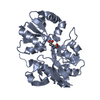
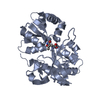
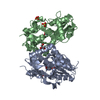

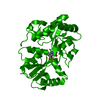

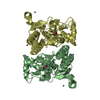
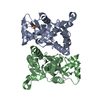
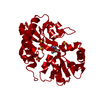
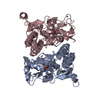


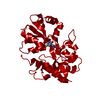
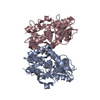
 PDBj
PDBj




